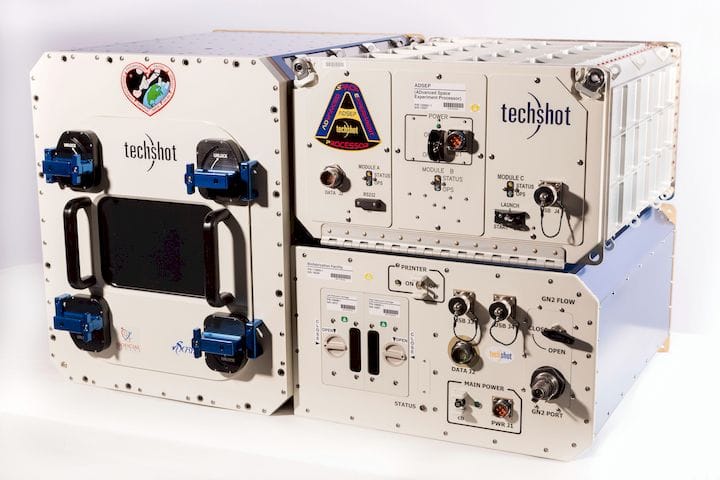![NASA’s BFF: BioFabrication Facility [Source: Techshot]](https://fabbaloo.com/wp-content/uploads/2020/05/image-asset_img_5eb0936531a6a.jpg)
A 3D bioprinter is launching to the International Space Station on the CRS-18 mission.
The space station has been the venue for several 3D printing experiments in recent years, primarily with equipment from California-based Made In Space. The first 3D printer was essentially a standard FFF device that had undergone significant redesign to operate safely in the microgravity environments safely.
But that 3D printer and its successors were printing parts from thermoplastics. As I understand it, the equipment was put through some specific operational tests to produce a set of prints. These were returned to Earth for examination to determine if the 3D printing process worked correctly. Afterwards the machine was packed away for future use.
But this week a new type of 3D printer is to join the crew on the ISS: a BioFabrication Facility, or “BFF”, as NASA terms it.
This is quite a different machine, although it uses the same motion principles as a standard 3D printer. Instead of depositing thermoplastic material, the BFF precisely deposits biomaterial, such as live cells, tissue or biostructural materials.
Bioprinting Tissue
Usually this is done in a hydrogel medium, as cells don’t make good structures until they multiply and grow into the desired shape. They’re held in place by the hydrogel medium, and sometimes require biocompatible support structures to ensure the growth does not collapse under gravity. I’m assuming one of the tests of the BFF will be to attempt bioprinting without support structures, because of microgravity.
The BFF was constructed for NASA by Techshot, an Indiana-based company that produces commercial bioprinters. For the BFF project, they teamed with Florida-based nScrypt, which produces high-precision micro-dispensing equipment.
The goals of this experiment are modest, yet could lead to much larger things. The first experiments will be to attempt to grow cardiac tissue using the BFF. This will be done within specialized cartridges made to fit in the BFF by Techshot. The cartridge will be stabilized for a longer period, during which the living cells will grow into more robust tissue. Eventually, the cartridge will be returned to Earth for examination.
Organ 3D Printing
Techshot’s long-term goal here is to prove the viability of 3D bioprinting tissue and organ replacements in space. Everyone knows there is a demand for replacement organs and tissue, but you may be wondering why Techshot wants to do this in space instead of on Earth.
The reason has to do with gravity. They explain:
“While researchers have seen some success with the 3D printing of bones and cartilage, the manufacture of soft human tissue, such as blood vessels and muscle, has proven more difficult. On Earth, when attempting to print with soft, easily flowing biomaterials that better mimic the body’s natural environment, tissues collapse under their own weight – resulting in little more than a puddle. But if these same materials are used in space in a microgravity environment, 3D-printed soft tissues will maintain their shape.”
Once printed, the bio-samples will be set to grow for up to 45 days before being ready for return to Earth.
BioFabrication in Space
Whether this approach is financially feasible has yet to be seen, but certainly it must technically work first, and that is what this test is all about.
If Techshot can prove this both technically and financially, it is possible there may eventually be orbital bio-manufacturing facilities that leverage these experimental results to produce vast quantities of replacement tissue for use on Earth.
Via NASA, Techshot and nScrypt











FELIXprinters has released a new bioprinter, the FELIX BIOprinter, which is quite a change for the long-time 3D printer manufacturer.